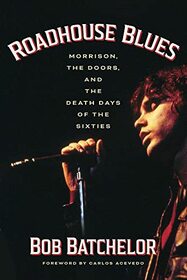Roadhouse Blues: Morrison, the Doors, and the Death Days of the Sixties by Bob Batchelor
Review by jjares
This is a different type of American band history. The subject is the organization, progression, and end of the Doors. I didn’t know what to expect at the beginning, but before long, I was enthralled. I was never interested in the Doors when I was a teen (although they were contemporaries), but this isn’t just about them. It explains the 1960s – one of the most turbulent in our history. The author sets the scene with the changes of the 1960s, with the end of Eisenhower and the beginning of Kennedy. Bob Denver became the songwriter (and later singer) of the period.
Raymond Manzarek was an American keyboardist with extensive experience in bands who had just finished his master’s degree at UCLA. He was walking along a Venice beach when he saw a friend (of two years), James Morrison, who was drifting (because he’d finished his bachelor’s at UCLA) and didn’t know what to do with himself. Jim was a poet and songwriter. Ray asked him to sing some of his songs. He recognized Jim’s specialness, a poet who could write songs. It was July 1965, and they decided to form a band “and make a million dollars.”
One thing that was critical to their success was that two were college-educated and decided to have a four-way decision process. They would give all four credit for the songs they wrote. They immediately got a recording contract with Columbia Records (Bob Dylan’s label). However, it didn’t work out. The Doors honed their skills at small LA bars (London Fog and Whiskey a Go Go) in 1966. Elektra Records gave them a record contract in late 1966.
LSD (acid) was still legal, and Jim often missed practices or gigs because of his alcohol and acid use. Before long, Jim started concentrating on booze (according to the author, extensive use of LSD would fry the brain). The author brings fascinating insight into Ray and Jim’s relationship. Jim was alone (he isolated himself from his autocratic father), and Ray became his elder relative who would emotionally support Jim in expanding his range (poetry, music, and voice).
It is essential to listen to the skills the band members brought to the Doors (the summary is at the beginning). There’s a good reason that all four band members were inducted into the Rock & Roll Hall of Fame in 1993. John Densmore used samba and bosa nova sounds in his drumbeats. Ray Manzarek was an organ virtuoso. Robert Krieger (the youngest member) and guitarist helped write songs. They each brought essential skills that helped create the Door’s unique sound.
The last few chapters discuss Jim’s death in Paris and its effect on the band. Then, the author ties the era together with the number of drug deaths (Jimmi Hendrix, Janis Joplin, etc.). He states there was no such thing as interventions or even assistance for drug and alcohol abuse at the time. However, soon after that rash of deaths, things changed.
Jim published two books of his poetry before his death, and others were published after his death. He always had a notebook with him, and when Jim was too drunk to contribute, the band members culled through his notebooks for inspiration while writing songs. I didn’t agree with all the views the author offered to explain the late 1960s, but it opened my eyes to how others might see this difficult time.
The author avers that the Doors are as popular as in the 1960s. They have sold over 100 million records and still counting.


